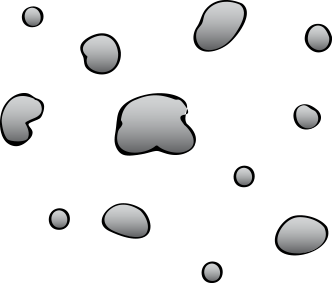what happens to the earth’s orbit speed as it gets closer to the sun
The Oort Cloud is the most distant region of our solar system. Fifty-fifty the nearest objects in the Oort Cloud are thought to be many times further from the Lord's day than the outer reaches of the Kuiper Belt.
Different the orbits of the planets and the Kuiper Belt, which lie mostly in the same flat deejay around the Lord's day, the Oort Cloud is believed to be a giant spherical trounce surrounding the rest of the solar organisation. It is like a big, thick-walled bubble made of icy pieces of space debris the sizes of mountains and sometimes larger. The Oort Cloud might comprise billions, or even trillions, of objects.
Home of Comets
Habitation of Comets
Because the orbits of long-period comets are so extremely long, scientists doubtable that the Oort Cloud is the source of most of those comets. For example, comet C/2013 A1 Siding Jump, which made a very shut laissez passer by Mars in 2014, will not return to the inner solar system for nearly 740,000 years.
The distance from the Sun to the Oort Cloud is so enormous that it'south useful to describe it not in the more common units of miles or kilometers, but astronomical units. Ane astronomical unit (or AU) is the altitude between Earth and the Sun. Pluto's elliptical orbit carries it every bit close as 30 AU from the Sun, and as far as 50 AU. The inner edge of the Oort Cloud, notwithstanding, is thought to exist between 2,000 and five,000 AU from the Sun. The outer edge might be x,000 or even 100,000 AU from the Sun — that's one-quarter to halfway between the Sun and the nearest neighboring star.
Though long-period comets observed amidst the planets are thought to originate in the Oort Deject, no object has been observed in the distant Oort Cloud itself, leaving it a theoretical concept for the time beingness. But it remains the about widely-accustomed explanation for the origin of long-menstruation comets.
Go further. Explore the Oort Cloud in Depth ›
x Need-to-Know Things About the Oort Deject
10 Need-to-Know Things Virtually the Oort Cloud
1
Predicted Realm
The Oort Cloud is a predicted collection of icy objects farther away than everything else in the solar organization. It fits with observations of comets in the planetary region of the solar arrangement, but scientists accept all the same to observe any object in the Oort Cloud itself.
2
Far, Far Away
The Oort Cloud is a spherical layer of icy objects surrounding our Sun, a star, and likely occupies space at a distance between about two,000 and 100,000 astronomical units (AU) from the Sun.
3
Long Way Circular
Long-period comets (which have more than 200 years to orbit the Sun) probably come up from the Oort Cloud, which is sometimes described as a "cometary reservoir."
Oort Cloud Illustration
4
Big Numbers
Predictions testify the Oort Cloud may contain more than a trillion icy objects.
5
Closer and Bigger
When comets from the Oort Cloud arroyo the Sun, their surface ices vaporize, producing a cometary atmosphere (a blackout) and often two tails (one dust, ane gas) that can accomplish hundreds or even millions of miles (or kilometers) in length. The activity subsides, and the coma collapses, when the comet'southward orbit carries it far enough abroad from the Sun.
6
Primitive
Some of the molecules found on comets formed before the Sun was born. They could not survive at temperatures and pressures found on or effectually Earth. By studying the weather under which primitive cometary molecules can grade, scientists can better understand what the environs of our solar arrangement was similar at its birth, which provides clues about how information technology formed and evolved.
vii
Exo-comets
Astronomers accept seen prove for comets disintegrating effectually other stars, the same style Comet ISON did when it grazed our Dominicus in 2013. Past using spectrometry to study those comets' chemical limerick, scientists tin compare the birth of our solar system to those of other planetary systems. (A planetary organization is the collection of planets, asteroids, etc. orbiting a star or stars. Our planetary system orbits the Sun, which is "Sol" in Latin. So we call our planetary system the solar organization.)
viii
A Long Trip
No missions have been sent to explore the Oort Deject nevertheless, but five spacecraft volition eventually get there. They are Voyager 1 and 2, New Horizons, and Pioneer 10 and 11. The Oort Deject is so afar, however, that the power sources for all five spacecraft will be dead centuries earlier they achieve its inner edge.
nine
Cold and Night
The frozen, comet-similar bodies of the Oort Deject are not capable of supporting life every bit we know it.
10
Deep Thinker
The Oort Cloud is named for Jan Oort, the Dutch astronomer who predicted its existence in the 1950s.
Oort Cloud Comet Siding Spring
Fast Fact
Fast Fact
Fifty-fifty though Voyager 1 travels nigh a million miles per day, the spacecraft will take nigh 300 years to achieve the inner purlieus of the Oort Cloud and probably another 30,000 years to exit the far side.
Kid-Friendly Oort Cloud
More than Resources
More Resources
- Where Does the Solar System End?
Source: https://solarsystem.nasa.gov/solar-system/oort-cloud/overview/


0 Response to "what happens to the earth’s orbit speed as it gets closer to the sun"
Post a Comment